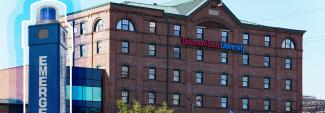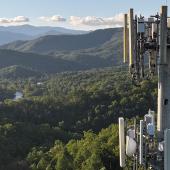The threat of wildfires is no longer only a concern for western states. More than 60,000 communities in the United States are at risk for outdoor fires like brush, grass, and forest fires, according to the U.S. Fire Administration.
Wildland fires have spiked in recent years, destroying tens of thousands of forests and encroaching on nearby communities. To help you prepare, FirstNet has tools designed for the demands of firefighting in wildlands and bordering areas.
Wildland urban interface
Wildfires are starting earlier, blazing stronger, and burning more acreage than in the past. Wildfire season used to be contained to the months of late summer through the end of fall. Now wildfires blaze throughout six or more months of the year.
A big consideration in preparing for wildfire season is the wildland urban interface. This is the zone of transition between unoccupied land and human development. The wildland urban interface is large and growing larger — adding approximately 2 million acres per year, according to the U.S. Fire Administration.
While wildfires can be healthy for forests, wildfires pose enormous threat to life and property in and near the wildland urban interface. Buildings and other structures in and near the wildland urban interface are at a greater risk due to catastrophic wildfire.
A toolkit for wildfires
Firefighters need specialized communication tools when battling wildland fires, especially when they threaten wildland urban interfaces. FirstNet was designed for public safety operations based on feedback from the public safety community.
The FirstNet Authority conducted a case study about the use of FirstNet for wildfires. We wanted to understand how FirstNet can best support firefighters battling the increase in wildland fires. Fire personnel shared their lessons learned in using public safety broadband in fighting wildfires.
FirstNet is an important tool in the fire service’s toolkit for fighting fires in the wildland urban interface. Some examples include versatile deployables to establish satellite coverage where it is needed and high-power user equipment to enhance signals at the edge of the network’s reach.
Establishing communications in remote areas
The FirstNet deployables fleet has many options to establish connectivity in remote locations. Deployables are mobile cell sites that link to FirstNet via satellite, do not rely on commercial power, and provide similar capabilities as a cell tower.
For example, one of the deployables in the fleet is a FirstNet Communications Vehicle. This deployable enhances communications, while also acting as a basic functioning command post. A FirstNet Communications Vehicle was deployed at the Marshall Fire in Colorado in 2022. This massive wildfire, fueled by hurricane force winds, damaged local infrastructure and left thousands homeless. The deployable established a FirstNet connection and served as an operational base for incident command staff.
Two other versatile and mobile deployables are the Compact Rapid Deployable (CRD) and miniCRD. The CRD can be transported on a pickup truck, helicopter, or boat. It is small enough to fit through doorways and into elevators for deployment from building rooftops to increase the area of coverage. The miniCRD is even more maneuverable. It consists of two 85-pound cases, one with the satellite backhaul connection to the network and one with the equipment to create the local connection to FirstNet devices.
Both CRDs and miniCRDs are especially helpful when wildfire threatens the wildland urban interface. They were both deployed when wildfire broke out near the National Center for Atmospheric Research (NCAR) Facility in Boulder, Colorado in March 2022. It was named the NCAR Fire because of its proximity to the facility. Ultimately, it burned 190 acres over 6 days and prompted the evacuation of 19,000 people.
The incident command post was set up near the NCAR facility in the foothills of the Rocky Mountains, and communication was limited. A FirstNet CRD and another deployable were sent to the command post to boost connectivity for responders.
“Having that very robust connectivity really kept us moving efficiently and effectively,” said Brian Oliver, Wildland Division Chief for Boulder Fire-Rescue.
Extending coverage at the network’s edge
Another FirstNet tool for the wildland urban interface is high power user equipment, or HPUE. HPUE can improve connectivity and uplink data speeds to keep firefighters communicating in areas where traditional devices might slow or drop off.
The Bristol Kendall Fire Protection District in Illinois uses HPUE. “In fringe network areas, HPUE allows us to stay connected with a higher level of reliability,” said Lieutenant Humza Shamsuddin, Technology Director for the agency.
The wildland urban interface may be at the edge of the network’s reach, but HPUE gives public safety devices the power to maintain connection to the network.
To learn more about how FirstNet is helping public safety and the fire services community to leverage innovative public safety communications, sign up for the Fire Take with Gary McCarraher.



















